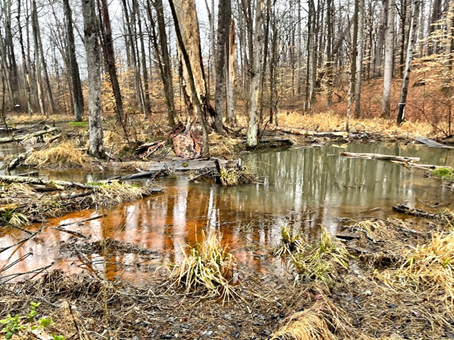IRON FLOC IN STREAM RESTORATIONS
- U&A
- Mar 31, 2021
- 3 min read
Updated: Apr 1, 2021
Have you ever walked by a local stream and noticed pockets of vibrant, rust-orange water and thought to yourself, “Wow check out that pollution!”? If so, you’re not alone, but you may have prematurely judged what might be the harmless wonder called iron floc. Iron floc is a naturally occurring phenomenon associated with iron-rich soils and is a feature especially common in Anne Arundel County, MD. Restoration projects in particular may experience high levels of iron floc, which can be misinterpreted as a project’s lack of success. The truth of the story of iron floc lies deep in the aquatic chemistry of the stream and floodplain soil connectivity.

Although iron floc may be mistaken as a byproduct of sandstone used in stream restoration projects, it is actually a natural part of Maryland’s Coastal Plain ecosystems. Floc (short for flocculate) is a loosely clumped mass of particles. Natural stream-wetland complexes express iron floc when there is subsurface drainage through iron-rich soils and groundwater discharge. Iron (Fe) is one of the most ubiquitous materials on earth (35% of the planet) and fourth most abundant in the Earth’s Crust (5% by mass). In soils, Fe content can range from 0.2% to 55%. Anne Arundel County soils are particularly rich in iron, but iron floc can be found everywhere on the planet where there are aquatic ecosystems with iron rich soils and groundwater.
The characteristic reddish-brown floc attached to branches, roots, and the cobble of stream beds is caused by bacteria that fixes (or oxidizes) oxygen onto iron into a form called a flocculate (floc). This happens when de-oxygenated water (such as groundwater) reaches a source of oxygen (such as a stream bed) and the iron oxidizing bacteria begin converting dissolved iron into an insoluble, rusty red-orange slime we see in many streams. When the flocs collect over very long periods of geologic time in slow moving streams or swamps, the mineral deposits form to eventually become stable bog iron or sandstone.
Local iron is an important part of the history of Anne Arundel County. At one time there were over 38 iron mines in the Northern portion of AA Co alone. This bog iron, also known as sandstone or ironstone, became known as “Arundel” ores, and played a pivotal role in the early history of America. These mines are indicators of the large quantities of iron in the soils, and were located near streams, bogs, or relict wetland areas. Even Captain John Smith observed the “red ooze” and recognized the economic value of the iron-rich soils and stream/wetland complexes, and he sent a barrel of bog iron back to England for evaluation of the quality of iron.

The floodplain/groundwater/stream connectivity that results from stream restoration projects may lead to iron floc accumulation particularly in low flow areas. Where in contrast, in urbanized, incised streams the connection between the floodplain and groundwater may be disrupted and therefore iron floc may be less apparent than it once was. Most scientists and resource managers have concluded it is unlikely that construction materials used in stream restorations, such as sandstone, woodchips, or sand, contribute much, if at all, to the iron floc seen at these stream restoration projects. Iron floc in RSCs (Regenerative Stream Conveyance) is more likely attributed to the restored integration of water between floodplain and groundwater.
It’s important to note that harmless iron floc occurs primarily around a pH level of 6.5 or 7 in freshwater habitats. When bright orange discharge is accompanied by high acidity (pH between 2.5-5.0), this could be an indicator of drainage from exposed acid sulphate soils or other acidic/sulfidic material such as pyrite from marine sediments, which is dangerous to water quality and aquatic organisms and requires mitigation.

Iron floc due to iron oxidizing bacteria is found in a large percentage of Anne Arundel County streams and does not indicate that the stream is polluted or unhealthy. In fact, the literature indicates that iron floc is a feature endemic to high quality, high iron systems. In a Chesapeake Bay Trust Pooled Monitoring study, U&A’s Howard’s Branch project (an RSC stream restoration with groundwater connection and abundant iron floc) scored highest on the benthic index of biotic integrity. As a result, it was named the best quality for benthic habitat uplift out of 25 stream restorations. Studies show that fish in natural, high quality streams with higher iron tend to be more diverse and abundant than in degraded, channelized streams. Additionally, iron floc has been positively correlated with an increase in salamander species abundances in small stream impoundments.

Understanding iron floc as a naturally-occurring phenomenon due to our iron-rich soils enables us to see past the uncommon rusty color and notice the benefits that connected stream and wetland complexes offer, such as habitat uplift and the cycling of nutrients which mitigates pollution in the Chesapeake Bay.

.png)

Comments